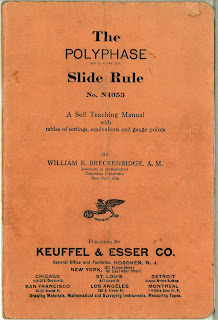This blog usually deals with urban decay, so let's expand it to engineering archaeology.
These are slide rules, which are manual computing devices. Logarithmic scales are engraved on plastic or aluminum. The scales can be slid back and forth relative to one another to multiply, divide, and calculate trigonometric functions. The yellow unit is a log/log Pickett, made in USA from aluminum. I bought it in high school (yes, I am that ancient). The problem with aluminum is you needed to lubricate the slide to prevent binding, and still it was jerky to move. The best slide rules were bamboo base with plastic covering because the bamboo slid smoothly along the grain with no need for a lubricant. Mahogany was second best.
This is an Aristo from Germany, made of plastic, complete with a box, metric ruler, and a sheet with many conversions. My dad bought this around 1960 but rarely used it.
The books that accompanied slide rules were full of examples on how to use the scales - many quite challenging. Users of slide rules needed to learn how to place the decimal point and how many decimal places were valid in a calculation. I learned how to use a slide rule from Isaac Asimov's An Easy Introduction to the Slide Rule, still available from Amazon. Many recent technical types just punch numbers into an electronic calculator and write down the numbers that appear, without thinking about the accuracy. That is why you often see invalid conversions such as "the distance was 1 mile or 1.60934 km". Well, no, the best you can say in this example is 2 km (but most would accept 1.6 km, or two-place accuracy).
At the top is a primitive form of slide rule, a metric conversion device. As I recall, Gerald Ford wanted us to convert to totally metric units by the end of the 1970s, but it did not fully happen. The ruler at the bottom is for reading distances directly from maps, with scales of 1" = 1000' or 1" = 2000'.
These are triangular rulers with various units. Some of the US Standard rulers had scales with 10, 20, 30, 40, 50, and 60 units/foot (as compared to the 12 units/foot, or inches, that are common on casual rulers). We used the scales to measure dimensions directly from engineering drawings or maps.
This is a Nestler's Schola compass set, used to draw circles of various diameters with ink or pencil. I rarely see compass sets here, but in Switzerland last summer, I noted that many bookstores had such sets. Swiss students may still learn traditional geometry with manual tools. The rods on the lower right are ink nibs. The tip was dipped into a bottle of India ink, which remained between the steel tips by capillary action.
The spring-tip pens were messy, so most draftspersons after World War II used technical pens, such as these Rapidografs. They were available with various width tips and made a precise line. They were messy, too, and needed to be cleaned with distilled water to keep the tips from gumming up. For use with plotting machines, you could buy Rapidografs with tungsten or jeweled tips, intended to not wear out when drawing on abrasive drafting film. I still use a Rotring 0.18 mm pen to write on photographic film negatives.
The aluminum device is an eraser guide (for precise erasing, what else?).
These are lettering guides, each one for a specific width technical pen.
The protractors are for measuring angle in degrees from engineering drawings or maps. But in the new computerized world, I think few people use protractors any more.
These are lettering guides, each one for a specific width technical pen.
The protractors are for measuring angle in degrees from engineering drawings or maps. But in the new computerized world, I think few people use protractors any more.
Finally, we have a fountain pen, in this example, the famous Parker 75 Sterling Cicelé from 1964. I have always used a fountain pen but find less and less opportunity to write with one because most contemporary paper is unsuitable and the ink bleeds. Luxury fountain pens have enjoyed a revival (similar to top-end mechanical watches), and some pens sell for $ thousands.
As you write and push down on the paper, the tip flexes and ink flows along the two halves to the tip, which is a combination of metals such as ruthenium, tungsten and rhenium. Traditionally, the best nibs were 18-karat-gold because the soft metal flexes and gently flows over the paper. Steel and lower grades of gold were scratchy, but now specialty steels may have solved that problem.
This has been a short survey of some of the contents in my desk. There were many other drafting tools in use before the 1980s such as Leroy Lettering Sets, pantographs, rub-on letters and textures, and pencils of various hardness. Will an archaeologist 100 years from now know how they were used? (Will a college graduate 2 years from now know how they were used?).














